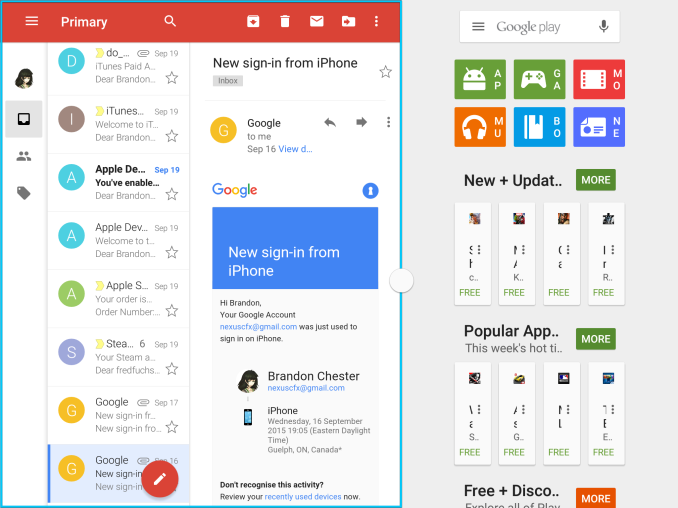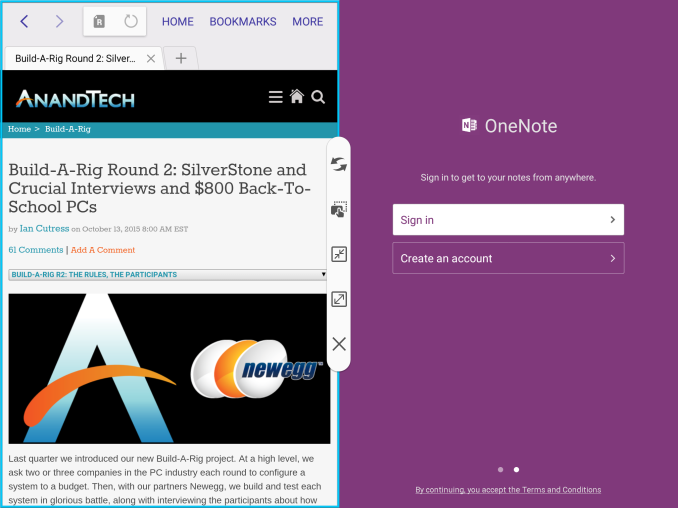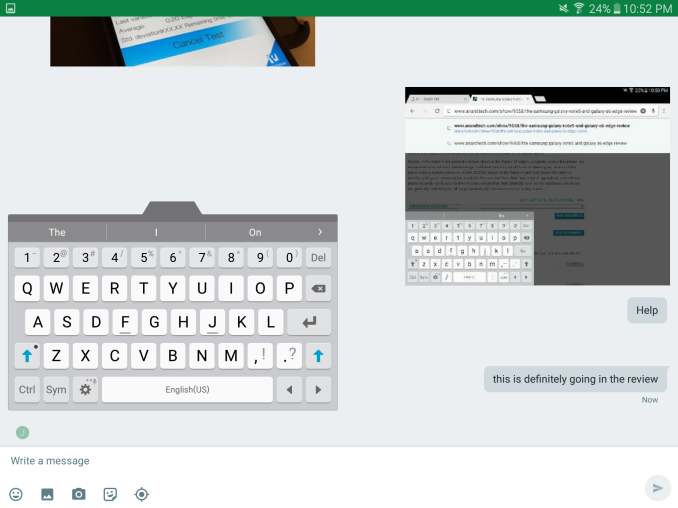The Samsung Galaxy Tab S2 Review
by Brandon Chester on October 15, 2015 8:00 AM ESTTouchWiz on Tablets
Much to the dismay of many Android enthusiasts, almost every Android device sold by an OEM will have that company's own skin running on top of Android, and their own custom applications as well. However, the skins running on top of Android often bring legitimate improvements to some of the problems in Android, and in fact many of the great features that exist in Android today were implemented in some form by an Android device OEM before it was officially added to the operating system.
Samsung's skin on Android is called TouchWiz. TouchWiz itself is a fairly known quantity by this point as it ships on all of Samsung's devices, and at a high level the UI and aesthetics of the UI on the Tab S2 are the same as the Galaxy S6 and Galaxy Note 5. However, Samsung has made changes to their included applications in order to improve their usability on a large display, which makes them one of the only first or third party developers to ever do that for Android apps, Google included.
Above is Samsung's file browser application, and I think it's a great example of a tablet application. Samsung uses a segmented layout, with a list of folders on the left and the files within a selected folder on the right. On top of that, the right side can have multiple tabs to allow the viewing and navigation of multiple folders that may be located at completely different parts of the file system. While I don't typically use file browsers on mobile devices, this is exactly how you make a file browser to take advantage of all the screen space available on a tablet.
While the Tab S2 comes with some pretty great tablet apps, there are some that don't do as good of a job using the screen's real estate. An example is Samsung's Memo app, which has some obvious space on the left and right sides which could be used to display a list of all of a user's notes like Apple's notes application on the iPad. You can also see the Samsung keyboard in the screenshot above. I think the size of the keys and the overall size of the keyboard is very good, although the autocorrect tends to give absolutely terrible suggestions. I do like the fact that Samsung has put a row of short number keys on the top which can greatly speed up typing when you need to insert numbers frequently.
While I don't want to dive into detail about each of the good and bad tablet apps on the Tab S2, I've put a few screenshots of the apps that I think are really good in the gallery below. I have to give Samsung credit for putting in the effort to actually design many of their apps to properly utilize their display. It's something even Google isn't doing, and that's something Samsung deserves kudos for.
Multitasking
The biggest feature that TouchWiz brings to Android tablets is support for multitasking. Samsung definitely deserves a lot of credit for implementing these features that don't exist within Android itself. I remarked in my iOS 9 review that it's honestly quite sad that Google allowed Apple to beat them to split screen multitasking on tablets when iOS apps have traditionally been designed for specific resolutions while Android applications have been scalable from day one. Of course, Samsung is working within limitations on what they can alter, and this imposes limitations on the functionality and quality of their multitasking implementation. Unfortunately, the vast majority of my experiences with multitasking on the Tab S2 have been far from positive.
Above is how the Gmail app and the Play Store app behave when put into split view multitasking. I really need to note that the claim that this works for all apps is not true at all; I have several apps that do not support it including Flipboard which is a massively popular news app. As you can see, neither application is scaling properly at all. It seems that Samsung isn't able to force the interface DPI such that they can have one side switching to the type of UI they would display on a smartphone. As a result, both sides are squashed with clipped text and other issues, and neither is usable at all.
The experience still has numerous issues even with Samsung's own apps. You can see above that the browser address bar gets completely squashed. Not only that, but the reader view touch target is still there and it makes it nearly impossible to actually hit the address bar to change it. If you adjust the split any further to increase the size of the OneNote window the header buttons in the browser start getting clipped. The fact of the matter is that no applications actually scale properly with this implementation at all, because proper scaling would entail switching to layouts similar to those used on smartphones which would work perfectly fine in these window sizes.
On top of the issues with the scaling of apps, using the multitasking features is also just downright confusing. Entering multitasking isn't too hard, as apps that work with it have buttons on the app cards in the multitasking drawer which brings it into split view and asks you to select another app for the other side of the display. Beyond that point things really break down. In the middle of the split you have a circle that you can drag to change the ratio. There's no animation for the dragging, presumably because there's no way to dynamically scale the interfaces and show it in an animated matter. iOS also doesn't scale the applications like that, but Apple still had an animation to give you some reasonable feedback to go along with the action you're performing.
Tapping the circle between the two apps brings up the menu with five icons that you see above. It's worth noting that there's no affordance to tell you that the circle can be tapped, and you'll almost certainly just discover it by accident. Once you do open the menu you're tasked with deciphering what the icons actually do. I was able to infer that the curved double arrows meant switching the apps between the sides of the screen, but I had no idea what any of the other icons did.
My initial guess for the x was that it closed the menu, but it actually closes whichever application you currently have selected. The other three icons from top to bottom are for dragging and dropping content between sides, moving the selected side into a floating window, and expanding the current window to fill the screen. Expanding the current window also happens to be the exact same action that the x performs, although the x button actually closes the application instead of just putting it into the background. The end user really shouldn't have to make such distinctions, and to most users it's completely redundant to have the two separate options.
Due to the limitations of how Samsung can modify window management, there's no way for them to bring up a full size keyboard like iOS's multitasking does. Instead, they put the keyboard into a floating window. I really can't fault them for this because it's the only thing they could of done, but the UX really is terrible. It's impossible to type with, and the keyboard stays in the window even after you've stopped using split screen mode. I actually couldn't figure out how to close it, and ended up having to Google the issue to figure out the solution. It turns out that the gear icon next to the symbol button which just kept bringing me to the keyboard settings can be long pressed to bring up a menu which alters the behavior of the button. I don't think I need to elaborate on all the obvious issues there are with that design, but suffice to say I don't think split screen mode works well for any applications that involve having to type things.
I don't feel good criticising Samsung's multitasking implementation, because the fact that they attempted to implement these features shows a great deal more effort than any other manufacturer or even Google. They obviously care about trying to provide a good tablet experience, because if they didn't they wouldn't have bothered to make tablet app UIs or implement any sort of multitasking. There are limitations on what they can do, and as a result the UX ends up being pretty poor. I have to give them credit for trying, but the experience is not even close to what you get on an iPad or on a Windows tablet where the apps work properly and the features are implemented at the OS level. Samsung's multitasking implementation is likely the best they could have possibly done given their constraints, but the end product just isn't very good, and I would never use it.


















162 Comments
View All Comments
extide - Thursday, October 15, 2015 - link
You only ever get bluescreens with bad hardware or really sketchy drivers. It is not possible for pure user mode code to cause a blue screenR. Hunt - Thursday, October 15, 2015 - link
Sure, much better if you want is a laptop replacement that can occasionally serve as a tablet, but as a pure tablet, the app store, which is still a wasteland, lets it down.kmmatney - Friday, October 16, 2015 - link
This. I was really disappointed with the App store, and there is still a big disconnect between Apps and normal windows programs, even in Windows 10. I ending up selling my Windows tablet - done for now. Might try again in a few years.thedons1983 - Saturday, October 17, 2015 - link
Completely different product, and is terrible as a tablet, even with Windows 10... The windows store is an absolute joke, moreover.colonelclaw - Thursday, October 15, 2015 - link
Considering that Samsung themselves manufacture the very processors in Apple kit, then why on earth are their own tablets so pathetically underpowered? According to these benchmarks the Air2/6S is anything between 2 and 3 times faster, a crazy difference. What's going on?blackcrayon - Thursday, October 15, 2015 - link
Maybe it's cost - Apple pays Samsung to fabricate Apple designed chips. But maybe Samsung doesn't want to pay Samsung (so to speak) to develop a similar design or would just rather use an existing chip to save development costs. After all, Samsung is incorporating close to "off the shelf " ARM cores (lower dev cost) vs. Apple's custom designed cores, & Apple is in the position to specifically optimize their OS and developer tools for it.limitedaccess - Thursday, October 15, 2015 - link
There is a two fold issue here.Apple uses their latest and highest power design for their largest SKUs. While Samsung for the Tab S line for two generations has basically used what can be considered their last gen design.
blackcrayon - Thursday, October 15, 2015 - link
(And as for the GPU, Apple is just using more / faster GPU cores than Samsung is choosing to, again cost I presume since nothing stops Samsung from using another especially in a tablet).lilmoe - Thursday, October 15, 2015 - link
The SoC price difference is easily mitigated with the price difference of the screen. For the same size/resolution, AMOLED is considerably more expensive than the best LCD.Outside of benchmarks, for the average users, the performance difference isn't THAT perceivable. Anandtech are heavily concentrating their "performance difference" pm browser javascript benchmarks, which aren't the whole picture when it comes to browsing speed. Both browsers on the Tab and iPad perform almost the same as most users see it. Don't forget, Android on Samsung's devices take full advantage of all the extra cores.
As Samsung sees it, users most probably prefer a better screen over faster performance. There's lots of merit to that compromise.
FlyBri - Thursday, October 15, 2015 - link
@lilmoe I have to totally disagree with you that the SoC price difference is mitigated with the price difference of the screen. Don't get me wrong, AMOLED screens are great (I have a Note 5 and Tab S 10.5), but the LCD screen on an iPad Air 2 is pretty damn good (I have one as well), and would be more than happy using that LCD if that meant getting a much more powerful SoC and a better overall tablet for the same price, or cheaper (which the Air 2 is). And you say that for average users the performance difference isn't perceivable -- except if you're playing graphics intensive games, which some average users do -- and the iPad Air 2 completely blows the Tab S2 out of the water, even though the Air 2 is already a year old. Also, many "average users" do a lot of web browsing and reading -- heck, Samsung copied the iPad's 4:3 aspect ratio because they felt more users are doing just that. Yet in exactly those scenarios, the Tab S2's battery life is absolutely horrible and completely unacceptable.People may prefer a better screen over performance, but in the specific scenario between the screens in the Air 2 and Tab S2, I don't think there is really any merit to excuse the difference in performance, battery life, and overall tablet experience. If you can now get an Air 2 for $350-400, the Tab S2, even if you factor in the more expensive AMOLED screen, is worth $300, maybe $350, but not $500. If Samung had to switch to a top quality LCD panel to give me a true Air 2 rival in terms of performance, battery life, tablet experience, etc., I'd happily go with that every single time.